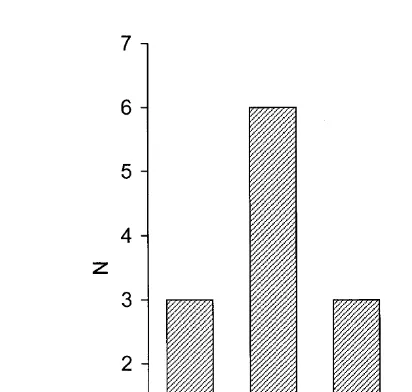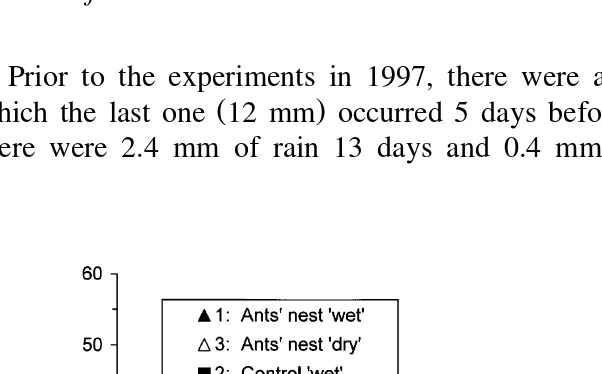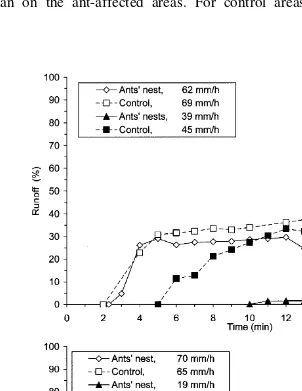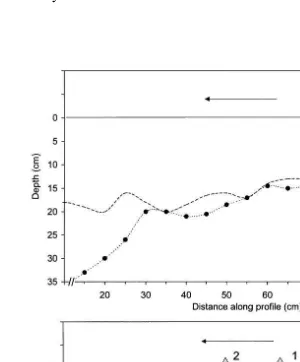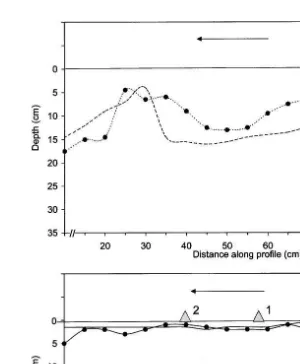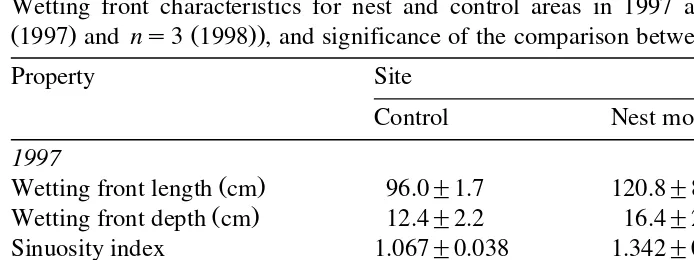Ž .
Geoderma 105 2002 1–20
www.elsevier.comrlocatergeoderma
The effects of ants’ nests on the physical, chemical
and hydrological properties of a rangeland soil in
semi-arid Spain
L.H. Cammeraat
a,), S.J. Willott
b, S.G. Compton
b, L.D. Incoll
ba
ICG, Institute for BiodiÕersity and Ecosystem Dynamics, Section Physical Geography,
UniÕersiteitÕan Amsterdam, Nieuwe Achtergracht 166, 1018 WV Amsterdam,
The Netherlands
b
Centre for BiodiÕersity and ConserÕation, School of Biology, UniÕersity of Leeds,
Leeds LS2 9JT, UK
Received 21 February 2000; received in revised form 28 January 2001; accepted 8 May 2001
Abstract
Ž .
The effects of the activity of seed harvesting ants Messor bouÕieri on the fertility, rainfall
infiltration, structural properties and water repellency of top soils were investigated in a semi-arid rangeland in SE Spain. The soil surfaces had a low vegetative cover and bare areas had a sieving crust. Rainfall simulation experiments were carried out over ants’ nest mounds and on control areas without surface ant activity in September 1997 and October 1998. The soils of the ants’ nests had a lower pH, higher concentrations of organic carbon and inorganic nutrients, higher structural stability and were more water repellent than the control areas. Infiltration rates on the control areas were comparable in both years. However, in 1997, infiltration was significantly higher on the nests than in control areas, whereas in 1998, infiltration was lower and wetting depth was reduced on the nests. These contrasting results are explained by a difference between the 2 years in the initial soil moisture content and the water repellency of soils and organic debris on the ant-affected areas. It is concluded that ants’ nests can act as sinks for water under slightly humid to wet conditions, whereas under extremely dry conditions, which prevail in summer and the beginning of autumn, infiltration is strongly reduced. Temporal variability in the initial conditions of the soil and spatial variability in ant activity interact to influence runoff generation at a fine scale and should be taken into account to fully understand runoff generation at the hillslope scale. The redistribution of materials by ants and their effects on soil properties may have consequences
)Corresponding author. Tel.:q31-20-525-7451; fax:q31-20-525-7431.
Ž .
E-mail address:l.h.cammeraat@science.uva.nl L.H. Cammeraat .
0016-7061r02r$ - see front matterq2002 Elsevier Science B.V. All rights reserved.
Ž .
policies of management, which would reduce the degradation of vulnerable land. Surface runoff and soil erosion in semi-arid areas decrease with increasing
Ž .
plant cover e.g. Lavee et al., 1998; Quinton et al., 1997; Castillo et al., 1997 , but where cover is low, the properties of the soil surface play a major role in
Ž .
governing the processes of erosion and infiltration Scoging, 1989 . Organisms in soil such as ants affect properties of the soil surface through the construction of nests. Nests are often, but not always, associated with higher concentrations
Ž
of nutrients and organic matter Lobry de Bruyn and Conacher, 1990; Dean and .
Yeaton, 1993 , and there may be a corresponding change in vegetative cover or Ž
biomass Rissing, 1986; Carlson and Whitford, 1991; Whitford and DiMarco, .
1995 . Ants may increase infiltration by improving porosity or decrease infiltra-Ž
tion by producing compacted surfaces, which facilitate runoff Lobry de Bruyn .
and Conacher, 1990 . Many of the results are contradictory, partly because of differences in techniques and in the biology of the species investigated, but also due to differences in physical characteristics of sites. The effects of the nests of the ant Pogonomyrmex rugosus on soil properties and vegetation varied with
Ž .
location and soil type within a single watershed Whitford and DiMarco, 1995 . Water repellency of soil material is reported for many Mediterranean and semi-arid ecosystems, but it is most often linked to hydrophobic substances
Ž .
directly derived from plant residues Doerr et al., 2000 . The activity of soil fungi and microorganisms may also be a source of hydrophobic substances,
Ž affecting soil hydraulic properties such as conductivity and sorptivity Wallis
.
and Horne, 1992; Hallett and Young, 1999; Doerr et al., 2000 . However, we have found no published work on the effects of soil macrofauna on soil wettability as reported here.
We measured the chemistry, particle size distribution, aggregate stability and wettability of soil associated with nests of the seed harvesting ant Messor
Ž .
( )
L.H. Cammeraat et al.rGeoderma 105 2002 1–20 3
12-month period. We conducted rainfall simulation experiments at different intensities over nests and on control areas during periods of high and low soil moisture content to determine the effects of nests on infiltration and erosion.
2. Site and methods
2.1. Site
The investigation was conducted in the Rambla Honda, the valley of an ephemeral river leading from the Sierra de los Filabres range, Almerıa Province,
´
Ž X X
.
SE Spain 37808 N, 2822 W . The climate is semi-arid, with mean annual
Ž .
rainfall of 256 mm but highly variable . Mean annual temperature is 15.8 8C, Ž
with summer maximum temperatures exceeding 40 8C Puigdefabregas et al.,
´
.
1996, 1999 . The site varies from 630 m altitude at the valley bottom to over 800 m on boundary ridges. The bedrock on the valley sides is a Devonian– Carboniferous slaty micaschist with quartz veins, with deep fluvial deposits on the valley floor, and extensive alluvial fans at the valley sides. We worked on
Ž .
the lower fans where the soils are Typic Torrifluvents Soil Survey Staff, 1992
Ž .
or Eutric FluvisolsrHaplic Arenosols FAO–UNESCO, 1988 with a 20–40-mm thick surface layer of fine gravels over a 2–10-mm thick subsurface crust of
Ž
loamy sands. The crust is of a sieving crust type Valentin and Bresson, 1992; .
Puigdefabregas, 1999 . The soil is a gravelly sandy loam with very weakly
´
developed horizons. Below 30–35 cm, the soil is more gravelly with no recognisable soil formation. The soil is moderately alkaline, with a low CaCO3
y1 Ž .
content which declines with depths from 9.1 g kg dry soil A-horizon to less
y1 Ž . Ž .
than 4.4 g kg dry soil C-horizon Puigdefabregas, 1995 . The very low
´
electrical conductivity reflects the low soluble salt content of the soil. Cation
Ž y1.
exchange capacity is low 25.0–36.4 mmol kgc reflecting the low content of
Ž .
clay and organic matter Puigdefabregas, 1995 . Soil bulk density ranges
´
between 1.52–1.65 Mg my3 for the crust and between 1.57 and 1.81 Mg my3
for the soils under the crust. Sediment yield and runoff are typically very low ŽKosmas et al., 1997 although a rare extreme rainfall event may increase these. considerably.
On the lower fans and drainage ways, the dominant shrub is Retama
Ž . Ž
sphaerocarpa L. Boiss., a deep-rooted legume, growing to 4-m high Pugnaire .
et al., 1996 . There is a diverse set of other plants, mainly winter annuals, between and beneath the canopy of these shrubs. Some lower areas of the valley have been cultivated occasionally in the past and the land is now used for sheep grazing, but this has been excluded from our experimental area since 1991 ŽPuigdefabregas et al., 1996 . The conspicuous nest entrances of the seed-
´
. harvesting ant M. bouÕieri are on the soil surface, particularly in the areas between shrubs. This species is found in arid sites throughout the westernŽ .
were measured and the area was then calculated by assuming that the mound was elliptical. The nests were revisited in November 1998, when the size and distance from the original of each new entrance mound was recorded. Several nests were located within a 48=28-m2 area demarcated so that the area of soil
affected by the ants’ nests within a 12-month period could be estimated.
2.3. Chemical properties of soil
In June 1997, samples of approximately 500 g were taken from nest mounds and from the top 5 cm of soil of a control site approximately 2 m distant. Four replicates of these pairs of samples were taken from open areas at least 2 m from
Ž
the nearest shrub because shrubs are known to affect soil properties Pugnaire et
. Ž .
al., 1996 . Samples were analysed Phosyn Laboratories, York, UK for pH,
Ž q
electrical conductivity, and concentrations of organic carbon, nitrogen as NH4
y.
and NO3 , potassium, phosphorous and magnesium. Chemical analyses fol-Ž .
lowed Anon., 1986 and are summarised as follows: pH and electrical conduc-Ž
tivity on a suspension of soil in demineralised water 1:2.5 soilrwater by .
volume ; organic carbon, by oxidation by potassium dichromate and sulphuric acid followed by spectrophotometry; NHq
, by extraction in 2 M potassium
4
chloride solution followed by determination by an ammonium-ion-selective electrode; NOy
, by extraction by saturated calcium sulphate solution followed
3
by determination by a nitrate-ion-specific electrode; K, by extraction by 1 M ammonium nitrate followed by flame emission spectrometry; P, by extraction by sodium hydrogen carbonate, complexing with ammonium molybdate and
solu-Ž .
tion spectrophotometry Olsen method ; Mg, by extraction with 1 M ammonium nitrate followed by determination by atomic absorption. Thus, available, rather than total, N and P were measured. Data for conductivity, NHq, NOy,
potas-4 3
sium, phosphorous and magnesium were log-transformed and organic carbon Ž .
( )
L.H. Cammeraat et al.rGeoderma 105 2002 1–20 5
2.4. Physical properties of soil
Samples for determination of soil aggregation and texture were taken from three active ants’ nests and from adjacent control sites. For each nest, separate samples were taken from the nest mound, the crust and the soil to 5 cm below
Ž .
the crust theAsubcrustB . Control samples were of the crust and subcrust only. Samples were bulked so we have no estimate of between-site variability. Each bulked sample was divided into two equal parts for determination of texture and soil aggregation. Soil texture was measured using the standard pipette and
Ž .
sieving method Gee and Bauder, 1986 .
Ž .
Aggregate stability was determined by applying a drop test Low, 1954 ,
Ž .
which is suitable for soils with low aggregate stability Imeson and Vis, 1984 .
Ž .
Twenty air-dry aggregates 4–4.8 mm in size were tested for each sample. The Ž .
number of drops d is used as an index of stability, indicating the number of raindrops required to fully disintegrate a single aggregate.
Ž
Wettability of the soil was determined by the WDPT method wetting depth .
penetrating time; Van’t Woudt, 1959; King, 1981 on three replicates of each sample. This test measures how long water repellency endures in the contact area of a water droplet with soil particles. The test was carried out on a surface
Ž .
of packed, air-dried soil -125mm for each type of sample as well as on the organic debris left by the ants at the nest entrance. Data were log-transformed to normalise the variance before statistical analysis.
2.5. Rainfall simulations
Ž y1.
Rainfall of varying intensity between 11 and 70 mm h was simulated on plots measuring 1=0.5 m2 in late September 1997 and early October 1998 with
Ž
a portable rainfall simulator ‘Amsterdam type’ dripping plate simulator; .
Bowyer-Bower and Burt, 1989 . Natural rainwater was used for the simulations, with approximately 23–25 l used in each simulation, equivalent to 46–50 mm rainfall. Plots were on the lower alluvial fans with slopes varying from 38to 148. Runoff, sediment yield, infiltration and depth of wetting front were compared
Ž .
between ants’ nests and control areas, with each pair of plots nest and control receiving rainfall of similar intensity. Runoff was collected in a small gutter at the lower end of the plot.
At the end of the experiment, a profile was dug through the centre of the long axis of each plot, and the vertical penetration of the clearly visible wetting front Žwetting front depth was measured at 5-cm intervals along the profile. The.
Ž
length of wetting front was also measured from this profile wetting front .
Ž .
Fig. 1. Number of entrance mounds N recorded over a 12-month period for 20 M. bouÕieri
Ž
colonies in the Rambla Honda mindicates multiple entrances where the mounds from each had
.
coalesced into a larger unit .
surface crust and at intervals from the surface crust down to the wetting front and the dry soil below it.
3. Results
3.1. Rate of relocation, area and density of nest entrances
Most colonies used two or more nest entrances with discrete mounds within Ž .
the 12-month period Fig. 1 . Six colonies used several entrances within a small
Table 1
Ž
Properties of soils of ants’ nest mounds and control sites in the Rambla Honda mean"S.E.;
. Ž .
ns4 , and significance of the comparison between sites by a paired t-test p
Property Site p
Control Nest mound
pH 8.1"0.1 7.4" -0.05 0.039
y1
Ž .
Conductivity mS cm 182"5 548"78 0.007
( )
L.H. Cammeraat et al.rGeoderma 105 2002 1–20 7 Table 2
Particle size distribution of soil samples taken from ants’ nests and control sites
Treatment Total soil Total fine earth
Gravel Fine earth Sand Silt Clay
)2 mm -2 mm )63mm 63–2mm -2mm
Ž .% Ž .% Ž .% Ž .% Ž .%
Nest
Mound 25.9 74.1 81.5 11.9 6.7
Crust 23.0 77.0 84.7 12.5 2.8
Subcrust 31.6 68.4 83.5 13.9 2.6
Control
Crust 21.4 78.6 79.0 16.9 4.1
Subcrust 27.3 72.7 84.7 13.0 2.3
Ž .
area, resulting in a large, diffuse mound m, Fig. 1 . For those colonies which moved their nest entrance, the mean distance between the different mounds of a
Ž .
single colony was 1.7"0.3 m mean"S.E.; ns25, range 0.3–6.6 m . Nest
2 Ž
mounds averaged 0.23"0.03 m in the area mean"S.E.; ns40, range 0.02–0.88 m2, with those over 0.5 m2associated with multiple entrances within
.
a small area . The total area of the 28 nest mounds of the 13 colonies within the 48=28-m plot was 4.4 m2, comprising 0.33% of the total area of the plot.
Ž .
Ž . Ž
Fig. 3. Water drop penetration time WDPT for soil samples from various sites values are of
.
mean"S.E., ns3 . Key: AC, ants’ nest crust; AS, ants’ nest subcrust; AM, ants’ nest mound material; CC, control crust; CS, control subcrust; OD, organic debris. Values with the same letter
Ž .
are not significantly different at ps0.05 Tukey test .
3.2. Chemical properties of soil
Ž .
Nest mounds had a significantly lower pH than bulk soil Table 1 . Electrical conductivity and concentrations of NOy, NHq, P, K, Mg and organic C were
3 4
significantly greater in soil from nest mounds.
()
L.H.
Cammeraat
et
al.
r
Geoderma
105
2002
1
–
20
9
Table 3
Results of the rainfall simulations in 1997 and 1998 under conditions of high and low soil moisture contents, respectively
Replicate Slope Duration Total rainfall Intensity Runoff Runoff Time to Final infiltration
y1 y1
Ž .8 Žmin. applied mmŽ . Žmm h . depth mmŽ . Ž .% runoff minŽ . rate mm hŽ . 1997
A1 14 37.00 23.8 38.6 0.3 1.3 10.00 37.9
C1 12 30.45 22.8 44.9 4.4 19.4 5.00 27.2
A2 12 22.00 22.8 62.1 5.3 23.2 2.30 45.6
C2 14 20.00 22.9 68.8 7.3 31.9 2.00 41.9
A3 6 20.00 22.8 68.3 6.3 27.5 2.75 38.6
C3 6 24.00 22.8 56.9 7.5 33.0 3.58 36.5
A4 6 30.75 22.8 44.4 0.9 3.9 4.08 42.4
C4 5 34.00 22.8 40.2 3.5 15.3 3.00 27.2
1998
A5 2.5 19.56 22.8 69.9 12.8 56.3 1.65 28.8
C5 3 21.05 22.8 64.9 5.6 24.5 2.25 48.3
A6 3 44.30 13.7 18.5 1.2 8.6 5.68 16.6
C6 3 36.15 13.7 22.7 1.8 13.0 8.08 19.0
A7 3 73.23 13.7 11.2 1.9 13.7 4.82 10.2
C7 4 54.00 13.7 15.2 1.1 8.1 4.65 14.0
less wettable than the control crust and subcrust soil Fig. 3 .
3.4. Rainfall simulations
Prior to the experiments in 1997, there were a series of rainfall events of
Ž .
which the last one 12 mm occurred 5 days before the experiments. In 1998, there were 2.4 mm of rain 13 days and 0.4 mm of rain 10 days before the
Ž . Ž y1.
Fig. 5. The relationship between total runoff % and rainfall intensity mm h for all rainfall simulation experiments; ‘wet’slow and ‘dry’svery low initial soil moisture contents in 1997
Ž . 2
and 1998, respectively. Line 1 ants’ nest ‘wet’ : r s0.989, regression slope ps0.0055; lines
Ž . 2 Ž . 2
2q4 control ‘wet’q‘dry’ : r s0.830; ps0.0043; line 3 ants’ nest ‘dry’ : r s0.889;
( )
L.H. Cammeraat et al.rGeoderma 105 2002 1–20 11
experiment. Consequently, the gravimetric soil moisture content was extremely
Ž y1. Ž y1. Ž .
low in 1998 -0.01 g g and low in 1997 0.03–0.04 g g Fig. 4 .
Ž .
For the first set of experiments on soil with low moisture content in 1997 , infiltration rates on the areas affected by ants were higher than on the control
Ž .
areas for rainfall of comparable intensity Table 3 . However, in 1998, on soil with very low moisture content, infiltration rates were higher in the control areas than on the ant-affected areas. For control areas, there were no significant
Fig. 6. Representative examples of the development of runoff with time in rainfall simulations at
Ž y1 y1.
Ž .
Fig. 7. Profiles of wetting fronts showing depths of infiltration under control areas A and C and
Ž .
through and around ants’ nests B and D after rainfall simulations in 1997 and 1998, respectively. The number next to the position of each nest entrance in B and D refers to the number of the associated wetting curve. The codes for rainfall intensity are HIshigh intensity )60 mm hy1;
( )
L.H. Cammeraat et al.rGeoderma 105 2002 1–20 13
Ž .
Fig. 7 continued .
layer on top of the crust. This was clearly visible at the cut made in the surface where the runoff was collected. Sediment yield was too low to measure for any of the experiments. The nest areas had a rougher topography due to the activity of the ants, and the final constant infiltration rates, and thus runoff, were all
Ž .
reached within 20 min, even at low rainfall intensities e.g. Fig. 6 .
In 1997, the wetting fronts under the ants’ nests were significantly more
Ž .
from the control areas in 1998 compared to 1997 is due to the lower intensities of rainfall applied.
4. Discussion
At our site, the nest mounds of M. bouÕieri had concentrations of macronu-trients and organic carbon two to eight times higher than in the surrounding soil. This is consistent with the differences in nutrient concentrations and pH between ants’ nests and their surroundings reported elsewhere, especially for larger ant
Ž
species with semi-permanent nests Lobry de Bruyn and Conacher, 1990; Dean .
and Yeaton, 1993; Eldridge and Myers, 1998 . As in other semi-arid environ-ments, the relatively high pH of soil is likely to make it difficult for plants to
Ž .
obtain sufficient phosphorus from the substrate Louw and Seely, 1982 . The increase in organic carbon should improve soil structure and increase
water-Ž .
holding capacity Day and Ludeke, 1993 , and the lower pH may well be related to higher organic matter contents. Increased water-holding capacity should benefit the plants directly and also indirectly via an associated increase in microbial activity, which will raise decomposition rates and result in the further release of nutrients. Increased aggregate stability will affect soil structure in a positive way. A more stable soil structure usually also indicates better macrop-orosity, which enables infiltration at low soil moisture suctions. When water enters the soil, it may percolate more easily and deeper through the areas with better soil structure.
( )
L.H. Cammeraat et al.rGeoderma 105 2002 1–20 15
per year, at least doubling the area of soil affected by nest building activity, and indicating that a singleAsnapshotB survey of the number of nests may consider-ably underestimate the total area of soil affected.
There has been considerable interest in the effects of plant cover on infiltra-Ž
tion of water and soil erosion in the Mediterranean region e.g. Castillo et al., .
1997; Quinton et al., 1997 , and on the role of hydrophobic soil material in the
Ž . Ž .
redistribution of soil water e.g. Imeson et al., 1992; Ferreira et al., 2000 . There is less work on the effects of macrofauna on these attributes. Most research on effects of soil fauna on soil chemical and physical properties have been carried out in Australia, North America and Africa. Results are often contradictory, indicating both increased infiltration due to improved porosity and
Ž soil structure, or a decrease due to the formation of compacted surfaces Lobry
.
de Bruyn and Conacher, 1990 . In the absence of a compacted surface, increased infiltration is what one would expect, given that an ants’ nest entrance is effectively a hole through the surface or subsurface crust which connects to underground tunnels. Furthermore, the tunnels and granaries of the nests of seed-harvesting ants are thought to be plastered with an anal secretion from the
Ž .
ants Bernard, 1968 , making them relatively impermeable to water. This is likely to increase the rate at which water is transported deeper into the soil profile. Increased infiltration over the ants’ nests was reported for M. capensis
Ž . Ž
in South Africa Dean and Yeaton, 1993 , for funnel ants Aphaenogaster
. Ž . Ž
barbigula in Australia Eldridge, 1993 , and for fire ants Solenopsis inÕictsa
. Ž .
and S. richteri in the southeastern United States Green et al., 1999 . However, Ž .
Wang et al. 1996 reported no significant effect on infiltration as entrances of
Lasius neoniger were closed during sprinkler experiments, although whether this was due to the ants actively closing entrances or the entrances simply becoming filled with dislocated soil particles was not clear. Similar closure of nest entrances was observed for M. bouÕierion limestone substrate in Spain, but infiltration rates were still higher, indicating that infiltration is not solely through
Ž .
the nest entrance itself Lambregts, 1999 .
Low infiltration capacity of crusted soils is perceived as a major agricultural problem in the warm seasonally dry tropics, and termite nests have similarly been shown to contribute to increased infiltration and thus soil improvement ŽMando et al., 1996 . However, it might be predicted that the mound of. excavated nest material could contribute to localised soil erosion. Our results show that this is not the case, at least for the range of rainfall intensities in our
Ž y1.
experiment up to 70 mm h . Sediment yields from our experiments were negligible, in accordance with results from larger permanent runoff plots nearby ŽKosmas et al., 1997; Puigdefabregas, 1999 .
´
.Ž .
observed that even under a relatively thin layer of chaff -5 mm , the wetting front was far less deep than under comparable bare areas of the mound. The control areas had less organic matter on their surface and they showed a comparable behaviour in both years.
Water repellency is often observed in sandy soils and also for areas under
Ž .
perennial plants in semi-arid to subhumid regions Imeson et al., 1992 . Plant-derived organic matter may act as a source of hydrophobic waxes which can
Ž coat sand grains, thereby influencing the hydraulic behaviour of the soil Franco
.
et al., 1995; Nicolau et al., 1996 . Water repellency of soil was positively related to organic matter content and negatively to clay content across southwestern
Ž .
Australia Harper and Gilkes, 1994 . At our site, nest mound and crust material were significantly more water repellent than crust material from the control area, and organic debris was strongly water repellent. Subcrust material from the control area was wettable, indicating the absence of mixing of particles with surface organic matter. Earthworms are often responsible for mixing the soil and
Ž incorporating organic matter, but there are no earthworms at our site S.J.
.
Willott, unpublished data , reinforcing the important effect of ant activity on the hydrological properties of the soil surface at this site. Microorganisms may produce water repellent exudates, and increased microbial activity in nutrient-rich soil may result in altered soil hydraulic properties such as sorptivity and
Ž .
hydraulic conductivity Hallett and Young, 1999 . Concentrations of nutrients
Ž .
were greater under ants’ nests Table 1 and if there is an associated increase in microbial activity, this too may contribute to the reduced wettability of subsoil material.
Further evidence for water repellency of the soil surface of nest mounds is that at high rainfall intensity, runoff increases rapidly in the first minutes of the
Ž
experiment, then declines by 10% after 10 min of rainfall Fig. 6B, ants’ nest,
y1.
( )
L.H. Cammeraat et al.rGeoderma 105 2002 1–20 17
stabilise. The wetting fronts for the control areas and the ant-affected area under very dry initial conditions show a comparable behaviour. Despite the strong variability in wetting front depth between the individual experiments, deeper and more heterogeneous infiltration was observed under the ant-affected areas with slightly higher soil moisture contents. Although soil surface conditions such as local stone cover or microrelief can be important in redirecting soil surface water flow, the clear wetting pockets shown in Fig. 7A strongly suggest that the preferential infiltration of water into the soil under the ants’ nests is important. At our site, the amount of overland flow is small when measured at broader scales, indicating that both sources and sinks for water occur at fine spatial
Ž .
scales Puigdefabregas et al., 1996; Kosmas et al., 1997 . Our experiments
´
demonstrate the importance of ant activity in water redistribution at these detailed scales, and this is the first research to document the dependence of hydrological behaviour of ants’ nest areas on the initial conditions of soil moisture content and repellency. With relatively wet soil, ants’ nest areas generate less runoff than their surroundings, and the threshold for the initiation of runoff is higher, while they may generate more runoff under dry conditions. There is often little or no rainfall during the summer months, and the nature of the first rainfall will dictate whether ants’ nests operate as sources or sinks for runoff. High intensity storms may increase surface runoff due to the water-repel-lent character of the soil surface, while low intensity storms, resulting in slow wetting of the soil, may lead to increased infiltration. Thus, temporal variability in the initial conditions of the soil and spatial variability in ant activity play a role in runoff generation at a fine scale and should be taken into account to fully understand processes at the hillslope scale.
Mosch and Dolf van Ommneren are thanked for their help during the fieldwork in 1998.
References
Anonymous, 1986. The Analysis of Agricultural Materials, 3rd edn. Ministry of Agriculture, Fisheries and Food, HMSO, London.
Bernard, F., 1968. Les Fourmis d’Europe Occidentale et Septentrionale. Masson et Cie, Paris. Bowyer-Bower, T.A.S., Burt, T.P., 1989. Rainfall simulators for investigating soil response to
rainfall. Soil Technol. 2, 1–16.
Ž .
Brandt, C.J., Thornes, J.B. Eds. , 1996. Mediterranean Desertification and Land Use. Wiley, Chichester, 554 pp.
Carlson, S.R., Whitford, W.G., 1991. Ant mound influence on vegetation and soils in a semiarid mountain ecosystem. Am. Midl. Nat. 126, 125–139.
Castillo, V.M., Martinez-Mena, M., Albaladejo, J., 1997. Runoff and soil loss response to vegetation removal in a semiarid environment. Soil Sci. Soc. Am. J. 61, 1116–1121. Day, A.D., Ludeke, K.L., 1993. Plant Nutrients in Desert Environments. Springer-Verlag, Berlin. Dean, W.R.J., Yeaton, R.I., 1993. The effects of harvester ant Messor capensis nest-mounds on the physical and chemical properties of soils in the southern Karoo, South Africa. J. Arid Environ. 25, 249–260.
Doerr, S.H., Shakesby, R.A., Walsh, R.P.D., 2000. Soil water repellency: its causes, character-istics and hydro-geomorphological significance. Earth Sci. Rev. 51, 33–65.
Eldridge, D.J., 1993. Effects of ants on sandy soils in semi-arid eastern Australia: local distribution and their effect on infiltration of water. Aust. J. Soil Res. 31, 509–518.
Eldridge, D.J., 1994. Nests of ants and termites influence infiltration in a semi-arid woodland. Pedobiologia 38, 481–492.
Eldridge, D.J., Myers, C.A., 1998. Enhancement of soil nutrients around nests entrances of the
Ž .
funnel ant Aphaenogaster barbigula Myrmicinae in semi-arid eastern Australia. Aust. J. Soil Res. 36, 1009–1017.
Ž .
( )
L.H. Cammeraat et al.rGeoderma 105 2002 1–20 19 Ferreira, A.J.D., Coelho, C.O.A., Walsh, R.P.D., Shakesby, R.A., Ceballos, A., Doerr, S.H., 2000. Hydrological implications of soil water-repellency in Eucalyptus globulusforests, north-central Portugal. J. Hydrol. 231–232, 165–177.
Franco, C.M.M., Tate, M.E., Oades, J.M., 1995. Studies on non-wetting sands: I. The role of intrinsic particulate organic matter in the development of water-repellency in non-wetting sands. Aust. J. Soil Res. 33, 253–263.
Ž .
Gee, G.W., Bauder, J.W., 1986. Particle size analysis. In: Klute, A. Ed. , Methods of Soil Analysis: Part 1. Physical and Mineralogical Methods. Am. Soc. Agron., Madison, USA, pp. 383–411.
Green, W.P., Pettry, D.E., Switzer, R.E., 1999. Structure and hydrology of mounds of the imported fire ants in the southeastern United States. Geoderma 93, 1–17.
Hallett, P.D., Young, I.M., 1999. Changes to water repellence of soil aggregates caused by substrate-induced microbial activity. Eur. J. Soil Sci. 50, 35–40.
Harper, R.J., Gilkes, R.J., 1994. Soil attributes related to water repellency and the utility of soil survey for predicting its occurrence. Aust. J. Soil Res. 32, 1109–1124.
Imeson, A.C., Vis, M., 1984. Assessing soil aggregate stability by water-drop impact and ultrasonic dispersion. Geoderma 34, 185–200.
Imeson, A.C., Verstraten, J.M., Van Mulligen, E.J., Sevink, J., 1992. The effects of fire and water repellency on infiltration and runoff under Mediterranean type forest. Catena 19, 345–361. King, P.M., 1981. Comparison of methods for measuring severity of water repellence of sandy
soils and assessment of some factors that affect its measurement. Aust. J. Soil Res. 19, 275–285.
Kosmas, C., Danalatos, N., Cammeraat, L.H., Chabart, M., Diamantopuolos, J., Farand, R., Gutierrez, L., Jacob, A., Marques, H., Martinez-Fernandez, J., Mizara, A., Moustakas, N., Nicolau, J.M., Oliveros, C., Pinna, G., Puddu, R., Puigdefabregas, J., Roxo, M., Simoa, A., Stamou, G., Tomasi, D., Usai, D., Vacca, A., 1997. The effect of land use on soil erosion rates and land degradation under Mediterranean conditions. Catena 29, 45–59.
Lambregts, C., 1999. The impact and assessment of soil fauna on soil surface properties of a degraded Mediterranean ecosystem. Unpublished PhD Thesis, University of Amsterdam. Lavee, H., Imeson, A.C., Pariente, S., 1998. The impact of climate change on geomorphology and
desertification along a mediterranean–arid transect. Land Degrad. Dev. 9, 407–422.
Lobry de Bruyn, L.A., Conacher, A.J., 1990. The role of termites and ants in soil modification: a review. Aust. J. Soil Res. 28, 55–93.
Lobry de Bruyn, L.A., Conacher, A.J., 1994. The effect of ant biopores on water infiltration in soils in undisturbed bushland and in farmland in a semi-arid environment. Pedobiologia 38, 193–207.
Louw, G.N., Seely, M.K., 1982. Ecology of Desert Organisms. Longman, London.
Low, A.J., 1954. The study of soil structure in the field and the laboratory. J. Soil Sci. 5, 57–74. Ludwig, J.A., Tongway, D.J., Eager, R.W., Williams, R.J., Cook, G.D., 1999. Fine-scale vegetation patches decline in size and cover with increasing rainfall in Australian savannas. Landscape Ecol. 14, 557–566.
Mando, A., Stroosnijder, L., Brussard, L., 1996. Effects of termites on infiltration into crusted soil. Geoderma 74, 107–113.
Marshall, T.J., Holmes, J.W., 1988. Soil Physics, 2nd edn. Cambridge Univ. Press, Cambridge. Nicolau, J.M., Sole, A., Puigdefabregas, J., Gutierrez, L., 1996. Effects of soil and vegetation on´ ´
runoff along a catena in semi-arid Spain. Geomorphology 14, 297–309.
Noy-Meir, I., 1981. Spatial effects in modelling of arid ecosystems. In: Goodall, D.W., Perry,
Ž .
R.A. Eds. , Arid-land Ecosystems: Structure, Functioning and Management, vol. 2. Cam-bridge Univ. Press, Sydney, pp. 411–432.
reproductive increase near ant nests. Oecologia 68, 231–234.
Schlesinger, W.H., Reynolds, J.F., Cunningham, G.L., Huenneke, L.F., Jarrell, W.M., Virginia, R.A., Whitford, W.G., 1990. Biological feedbacks in global desertification. Science 247, 1043–1048.
Scoging, H., 1989. Runoff generation and sediment mobilisation by water. In: Thomas, D.S.G.
ŽEd. , Arid Zone Geomorphology. Belhaven Press, London, pp. 87–116..
Soil Survey Staff, 1992. Keys to Soil Taxonomy, 5th edn. SMSS Technical Monograph, vol. 19. Pocahontas Press, Blacksburg, USA.
Valentin, C., Bresson, L.-M., 1992. Morphology, genesis and classification of surface crusts in loamy and sandy soils. Geoderma 55, 225–245.
Van’t Woudt, B.D., 1959. Particle coatings affecting the wettability of soils. J. Geophys. Res. 64, 263–267.
Wallis, M.G., Horne, D.J., 1992. Soil water repellency. Adv. Soil Sci. 20, 91–146.
Wang, D., Lowery, B., Norman, J.M., McSweeny, K., 1996. Ant burrow effects on water flow and soil hydraulic properties of Sparta sand. Soil Tillage Res. 37, 83–93.
Whitford, W.G., DiMarco, R., 1995. Variability in soils and vegetation associated with harvester
Ž .
ant Pogonomyrmex rugosus nests on a Chihuahuan Desert watershed. Biol. Fertil. Soils 20, 169–173.
